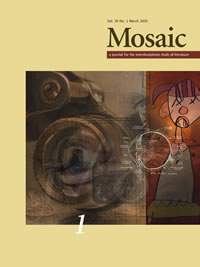Issue 38.1
Overview

General Issue
Published: March 2005
View the issue introduction or see the issue summary and contents below.
10 essays, totalling 192 pages
$16.95 CAD
Following the current Mosaic special issue, The Photograph, volume 38.1 will feature "the photograph" again. Look for ten original essays covering such topics and titles as: photographic realism in Salman Rushdie's Midnight Children; photographic media in W. G. Sebald's Austerlitz; the epistemology of Cindy Sherman; the national photographic in Margaret Atwood's Surfacing and Nadine Gordimer's July's People; Dubliners, photography, and the rejection of realism; and spirit photography.
Airbrushed History: Photography, Realism, and Rushdie’s Midnight’s ChildrenEdward Barnaby Informed by Rushdie’s non-fiction, the social history of photography in India, and the work of Debord and Sontag, in this reading of Midnight’s Children, I contend that Rushdie uses fictional photographs to stage a realist satire of colonial and nationalist ideologies, thus countering various attempts to label Midnight’s Children as magic realism or exoticism. | |
Decapitated Forms: Theresa Hak Kyung Cha’s Visual Text and the Politics of VisibilityThy Phu Although the politics of visibility have often been celebrated as a means of representing marginalized histories and subjectivities, the role of the visual in articulating this politics, as well as the persistence of invisibility, has yet to be explained. Focusing on select works by avant-garde artist Theresa Hak Kyung Cha, this essay demonstrates that the visual text demonstrates a critique of, rather than a faith in, the politics of visibility. | |
Trauma Obscura: Photographic Media in W.G. Sebald’s AusterlitzSamuel Pane Informed by Cathy Caruth’s discussion of trauma theory, Peter Brooks’s notion of narrative desire, and Roland Barthes’s investigations into photographic viewing, this essay examines photography in W.G. Sebald’s Austerlitz as a locus of trauma rather than as a transparent device of historical testimony. | |
In the New Republic of Digital (Re)ProductionJames R. Watson and Trish Maud A brief historical account of the unfolding of photography as a weapon of the state against revolutionaries and troublemakers serves as context for our description of recent developments in digital imaging production and reproduction. We distinguish specific photographic and digital imaging practices from oppressive state security practices using the same technology. | |
National Photographic: Images of Sensibility and the Nation in Margaret Atwood’s Surfacing and Nadine Gordimer’s July’s PeopleLaura Wright Psychological frameworks for both a national and sensible “imagined community” are socially transmitted via photographic images and illustrations to the female protagonists of Atwood’s Surfacing and Gordimer’s July’s People. This essay examines the protagonists’ disruption of such visually instilled sensible and colonizing behaviour. | |
The Epistemology of Cindy Sherman: A Research Method for Media and Cultural StudiesBarry J. Mauer This essay is a manifesto for a cinematic/electronic media and cultural studies research method. I argue that Cindy Sherman’s Untitled Film Stills were produced using such a research method and I adapt this method for use within media and cultural studies. | |
“Turn it, a little”: The Influence of the Daguerreotype and the Stereograph on Emily Dickinson’s Use of Manuscript VariantsMelanie Hubbard The advents of the daguerreotype and the stereograph, with their non-self-identical physical properties and the naturalizing discourses surrounding their emergence, gave Dickinson the terms with which to think about knowledge and representation in words. Her retention of variants in the poems enacts analogously non-self-identical representational strategies. | |
Showings Forth: Dubliners, Photography, and the Rejection of RealismEloise Knowlton This essay asks what Dubliners may owe to a realism derived not from literary realism’s models, but from a photographic realism newly emergent as photography moved, during Joyce’s youth, out of the studio and into the street. Employing a distinction from Lyotard’s early work, it claims for late nineteenth-century photography a disruptive figural force that erodes a prior, painterly, discursive order of the photographic, and traces this figurality in Dubliners. | |
Ghost in the Machine: Photographs of Specters in the Nineteenth CenturyPaola Cortés-Rocca “Spirit Photography” consists of photographs in which the sitter appears near to the shadowy image of a dead beloved. This essay examines the ways that this practice both reaffirms the early promise of immortality made by photography and presents the technological catastrophes of the twentieth century. | |
Gender, Photograph, and Desire: Visual Practices in El amor es una droga dura by Cristina Peri RossiClaudine Potvin El amor es una droga dura by Cristina Peri Rossi is a novel about images. Through a discussion of gender, desire, and photography, this essay shows how the visual narrative installs fiction into a text-museum, the photograph paradigm as a fetish within the text, and the camera as an illusory mediator between the photographer/artist and the model/reality. |